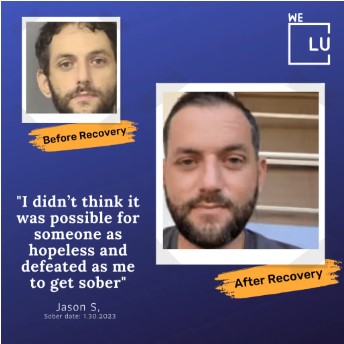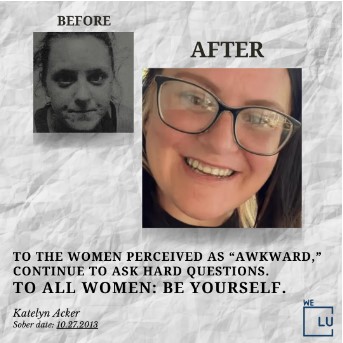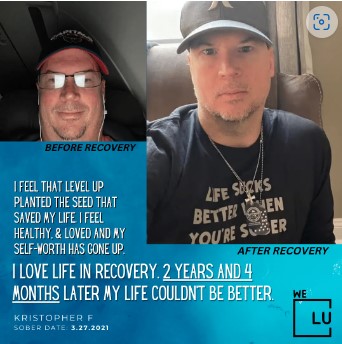DMT Drug Guide. Understand What is DMT Drug & DMT Meaning. Find DMT Drug Pics. Uncover DMT Trip Effects. Drugs with DMT, & Dangers of DMT.
What is DMT? DMT (N,N-Dimethyltryptamine) is a potent hallucinogenic drug that produces intense visual and auditory hallucinations. Its effects are relatively short, typically lasting between 30 minutes to an hour. However, the drug can still be detected in your system for a certain period after ingestion. Continue to read for more facts about DMT drugs.
By We Level Up | Editor Yamilla Francese | Clinically Reviewed By Lauren Barry, LMFT, MCAP, QS, Director of Quality Assurance | Editorial Policy | Research Policy | Last Updated: November 14, 2023
What is DMT Drug? What is DMT’s Meaning?
DMT, or Dimethyltryptamine, is a powerful psychedelic substance naturally occurring in some plants and synthesized in laboratories for recreational use. It is known for its intense visual and sensory experiences, often described as “breakthrough experiences” or “DMT trips.” The effects of the DMT drug typically last for a relatively short time, usually around 30-60 minutes. Still, they can be highly intense and profoundly impact users’ perception of reality. The DMT drug is classified as a Schedule I controlled drug in the United States.
DMT drugs carry an elevated risk of abuse with no accepted medical use. Due to its illegal status, the DMT drug has been given many street names, including Dimitri, Businessman’s Trip, Fantasia, and The Spirit Molecule. Continue reading more about what is DMT.
What is DMT Drug?
Wondering what is a DMT drug? DMT (N, N-Dimethyltryptamine) is a powerful hallucinogenic substance that occurs naturally in many animals and plants, including humans. DMT is a psychedelic drug that produces intense visual and auditory hallucinations, often described as a “breakthrough experience” or a “tripping on DMT.” Users may experience DMT effects on the brain, with profound changes in perception and consciousness, including:
- A sense of timelessness.
- Feelings of oneness with the universe.
- Encounters with entities, such as what the users call “DMT elves,” or beings that seem to be from other dimensions or planes of existence.
DMT can be taken in various ways, including smoking, vaporization, injection, or oral consumption. Smoking or vaporizing is the most common method of administration because it creates an almost immediate and intense effect. It is known to have a rapid onset and short duration of action, typically lasting only 15-30 minutes. Due to its potent effects and potential risks, DMT drugs should only be used under medical supervision, which is illegal in many countries.
DMT Drug Classification & Legal Status
What is a DMT drug’s classification? DMT is classified as a Schedule I controlled substance in the United States, which means it is illegal to manufacture, distribute, or possess without a license or prescription.
DMT Effects
The effects of taking DMT can vary depending on the dose taken and how it was ingested. Users commonly report euphoria upon consumption, followed by intense hallucinations lasting up to 30 minutes. Visuals may include bright colors or shapes that dance and move before the user’s eyes. The experience is often described as being out of the body, and users can feel like they’re going on a journey through time and space.
Users have also reported feeling more connected with the universe or having spiritual experiences after taking DMT. While these effects are often positive, DMT can be dangerous if not handled responsibly in a secure setting with someone who comprehends what they’re accomplishing. No drugs are approved to mix with DMT, so combining it with other substances should be avoided at all costs.
Tripping on DMY comes with many risks and should only be considered carefully and responsibly. Be sure to research all available information before using and always talk to your doctor if you have any questions or concerns.
Is DMT Dangerous? What is a DMT Drug’s Danger?
DMT (Dimethyltryptamine) is a powerful psychoactive compound that can cause various physical and mental effects. While DMT is not considered physically addictive, there are potential risks. So, is DMT dangerous? Yes, there are dangers associated with its use. Some of the dangers of DMT use include:
- Psychological effects: DMT can cause intense paranoia, anxiety, and panic attacks. It can also trigger psychotic episodes in people predisposed to mental health issues.
- Physical effects: DMT can cause various physical effects, including increased heart rate, elevated blood pressure, nausea, and vomiting.
- Dependence: While DMT is not considered physically addictive, repeated use can lead to psychological dependence.
- Legal issues: DMT is illegal in most countries, including the United States. Possession, distribution, and use of DMT can result in legal consequences.
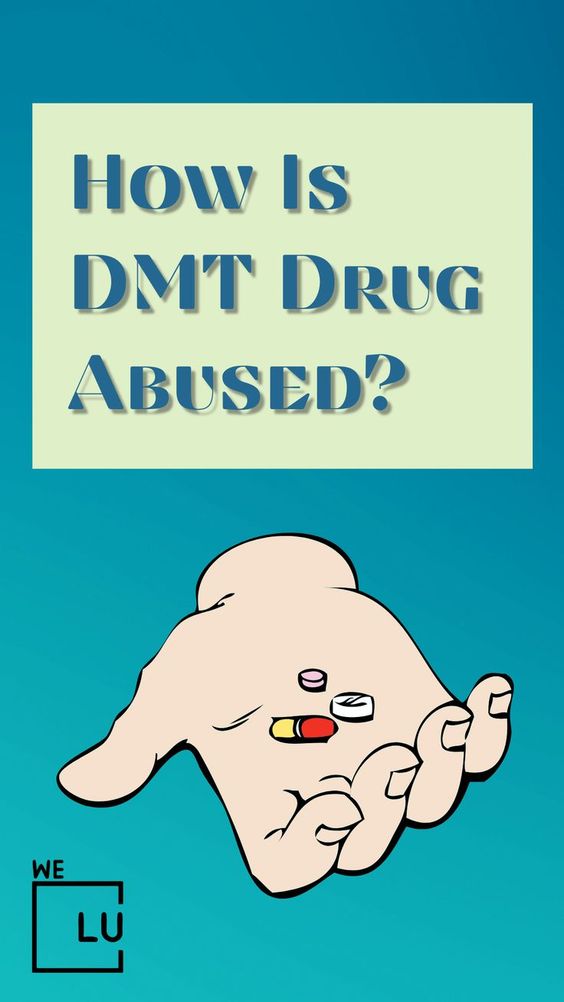
People contemplating what is a DMT drug and using it should first understand the potential risks associated with DMT use and approach the substance cautiously. If you are considering using DMT, it is advised that you confer with a healthcare specialist or addiction professional to discuss potential risks and options for safe use.
First, get answers to common questions like, is DMT a drug? Yes, it is. DMT is a powerful substance with positive and negative effects. And learn what is a DMT drug’s proper dose. DMT dosage should only be administrated under the care of a qualified specialist in a secure and controlled environment. Continue reading about what is a DMT drug’s effects.
Drugs With DMT. What is DMT Combined With?
DMT is a powerful psychedelic drug sometimes combined with other substances to enhance or modify its effects. Some of the most common drugs that are used in combination with DMT include:
- Ayahuasca: Ayahuasca is a traditional South American brew containing DMT and other psychoactive compounds. It is often consumed as part of shamanic or religious ceremonies.
- MAO inhibitors: MAO inhibitors are a type of antidepressant medication that can enhance the effects of DMT by blocking the breakdown of the drug in the body. This can lead to a longer and more intense experience.
- 5-MeO-DMT: 5-MeO-DMT is a related compound structurally similar to DMT and produces similar effects. It is often combined with DMT to enhance or prolong its effects.
- LSD: LSD is another potent psychedelic drug that may create intense hallucinations and change forms of consciousness. It is sometimes combined with DMT to create a more intense and extended experience.
- Ketamine: A dissociative anesthetic that can deliver hallucinogenic effects at higher doses. It is sometimes combined with DMT to have a more intense and complex experience.
The use of any of these drugs, alone or in combination with DMT, can be dangerous and should only be done under the supervision of a trained medical professional.
What is DMT Slang? What are DMT Street Names?
The uses of DMT drug slang can vary by location and can change over time, so it’s essential to be familiar with the chemical name and its effects rather than relying solely on slang terms. DMT is known by a few street names, including:
- Dimitri.
- The Spirit Molecule.
- Businessman’s Trip.
- Fantasia.
- Dust.
- 45-Minute Psychosis.
There are many more DMT Street Names / DMT Slang Names.
What Does DMT Look Like? (DMT drug pics)
After extraction from the DMT in plants, DMT typically appears as a white, crystalline powder or a yellow-orange, a waxy substance with a strong odor. The powder form of DMT is usually consumed by smoking or vaporizing it with a particular device, such as DMT pens. The waxy form of DMT is often ingested orally by blending it with a drink or using a process known as “change,” which involves smoking a mixture of DMT with other plants.
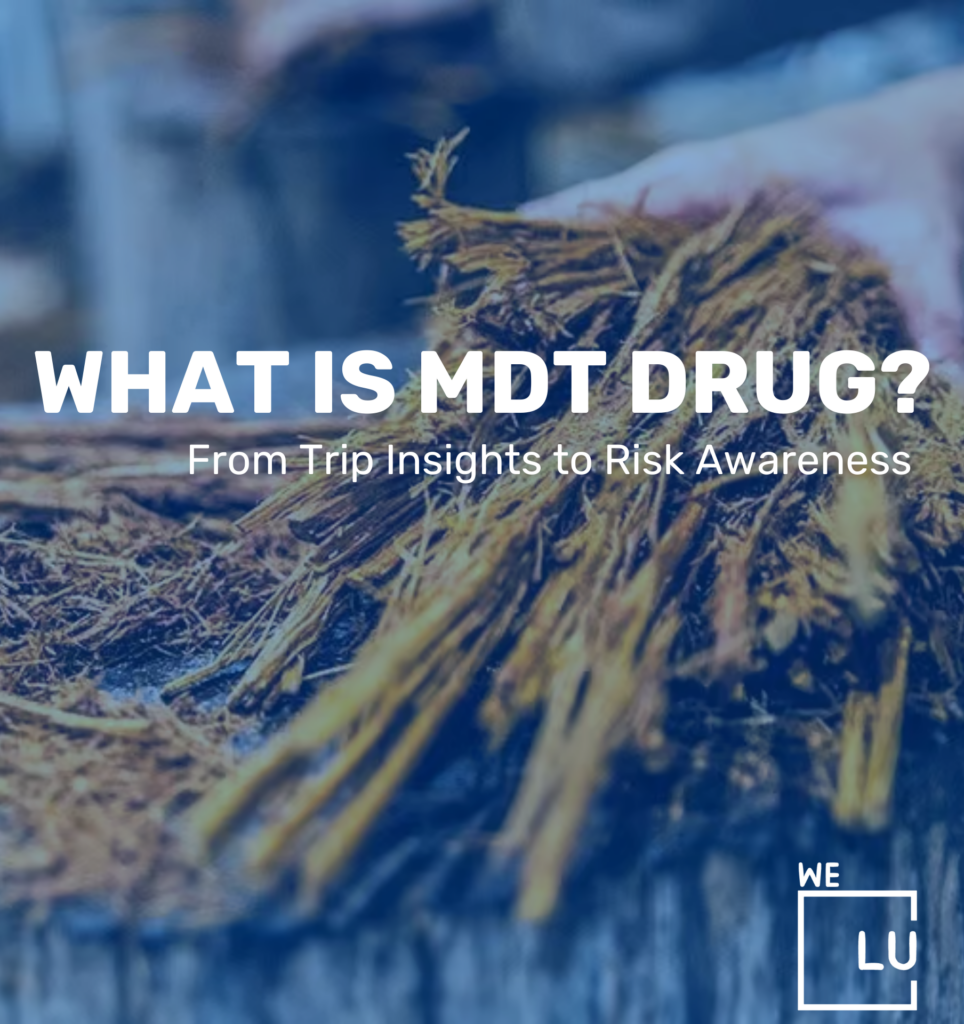
Skip To:
Learn More:
- DMT Tripping, What Is It Like & What Are The Risks?
- DMT Brain, Side Effects & Health Risks of DMT on the Brain
- DMT Street Names. What is DMT Slang Name? DMT Side Effects, Is DMT Addictive? DMT Dangers.
- Hallucinogens Addiction
- Research Chemicals Drugs
- Are Psychedelics Addictive?
- Mushrooms Drug
- How Long Does A High Last?
- How To Get Unhigh?
- How Many Days Does It Take To Get Addicted?
DMT Trip Experience
A DMT trip refers to an individual’s experience of consuming DMT (Dimethyltryptamine) and the ensuing intense and often profound and otherworldly hallucinations and sensations that they experience.
DMT is known for producing some of the most compelling and intense psychedelic experiences, and the trip’s onset is usually rapid, within seconds to a minute after consumption. DMT trips are characterized by a series of intense sensory experiences that may include:
1) Visual hallucinations: DMT can induce profound and vivid visual hallucinations, including geometrical shapes and patterns, alien-like entities, and intricate landscapes.
2) Auditory hallucinations: Some users hear strange sounds, music, or voices during their DMT trips.
3) Changes in perception of time and space: Many people report that time seems to slow down or become irrelevant during the trip. In contrast, others feel transported to other dimensions or alternate universes.
4) Ego Dissolution: Some users experience a sense of ego death, feeling like they have merged with the universe or a higher power.
DMT trips can be powerful and transformative experiences described as life-altering, spiritual, and even mystical. DMT trips can also overwhelm and induce anxiety, fear, or panic. It is essential to approach DMT cautiously and consume it safely and responsibly. It is also vital to understand that DMT is illegal in most countries, and its use may carry legal consequences. DMT trips may vary between individuals, and one person’s experience may be vastly different from that of another.
How Long Does DMT Last?
How long does a DMT high last? The effects of DMT (dimethyltryptamine) can vary in duration and intensity depending on the method of administration, dosage, and individual factors. Generally, the effects of DMT are relatively short-lived compared to other psychedelics.
When smoked or vaporized, the effects of DMT usually onset rapidly, within seconds to a few minutes. The peak effects typically last for 5-15 minutes, totaling 20-30 minutes. The effects can last for several hours when taken orally with an MAOI (monoamine oxidase inhibitor) to prevent a breakdown in the digestive system. Still, the onset and duration of the effects are slower and more gradual compared to smoking or vaporizing.
During a DMT experience, users typically report profound and intense alterations in consciousness, including vivid auditory and visual hallucinations, an altered sensation of time, and a sensation of connection to a higher power or universal consciousness. How long does DMT high last, and what are its effects? After the effects of DMT wear off, users may feel a sense of afterglow or introspection that can last for several hours or days.
Is DMT Legal?
In the United States, DMT is classified as a Schedule I chemical under the Controlled Substances Act, meaning it is deemed to have a heightened prospect for substance use disorder and no accepted medical use. Possession or distribution of DMT can result in severe criminal penalties, including fines and imprisonment.
Some indigenous cultures may use DMT-containing concoctions such as ayahuasca, which combines DMT with other plants to create a longer-lasting and more complex experience in specific religious or ceremonial contexts. However, the legality of ayahuasca varies by jurisdiction. Still, DMT is a Schedule I substance in many countries, meaning it is illegal to manufacture, possess, or distribute it
What Does DMT Look Like? DMT Drug Pics.
The DMT drug is made with extractions of plants that contain DMT, including several species of shrubs and trees. DMT (Dimethyltryptamine) can take several forms when processed from natural plants or synthetic means. So, what does DMT look like? See below DMT drug photos and plants with DMT.
DMT Comes From What Plant?
DMT can be extracted from some plants, such as the Ayahuasca vine or Mimosa hostilis root bark. In its pure crystalline form, DMT can appear as a white or yellowish powder, similar in appearance and texture to flour or sugar. DMT crystals are often described as having a strong, acrid smell similar to burning plastic.
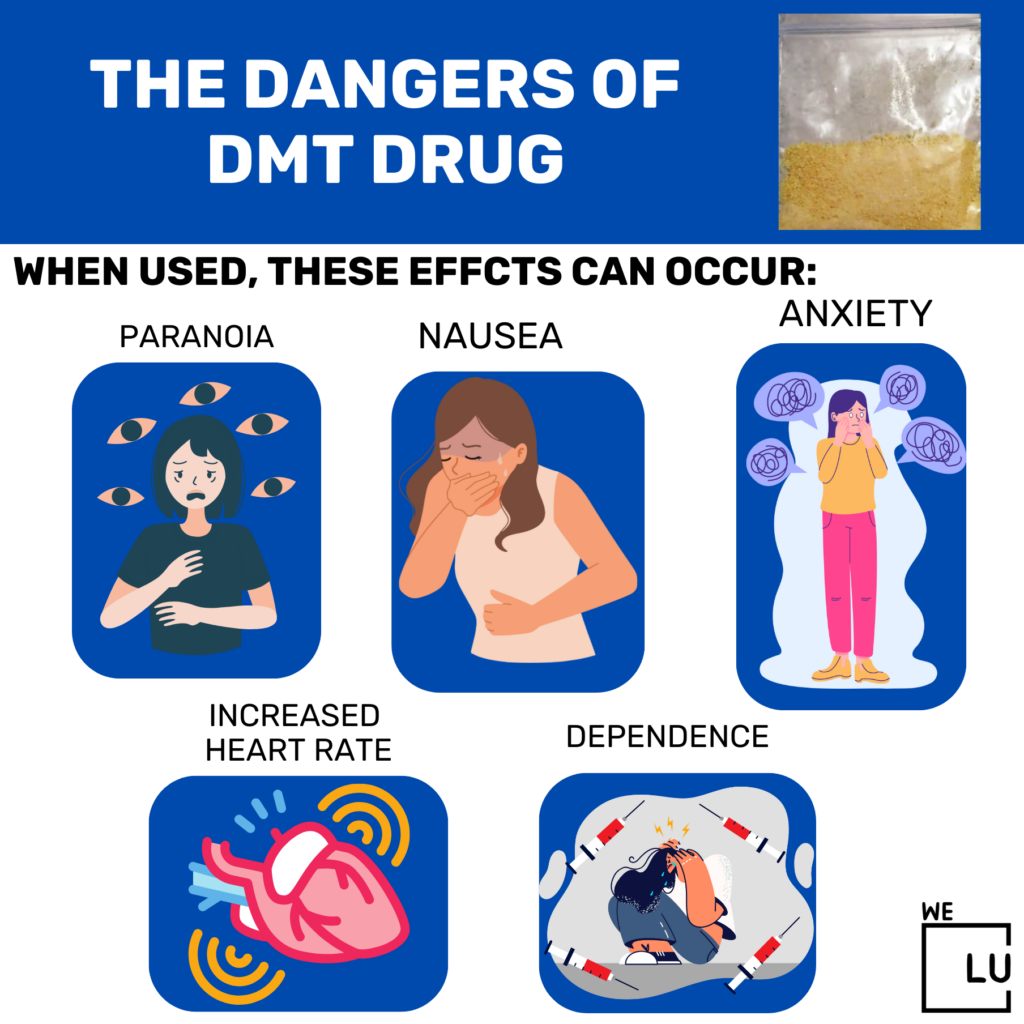
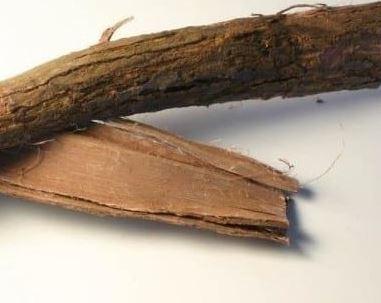
What is DMT’s Plant Bark Look Like?
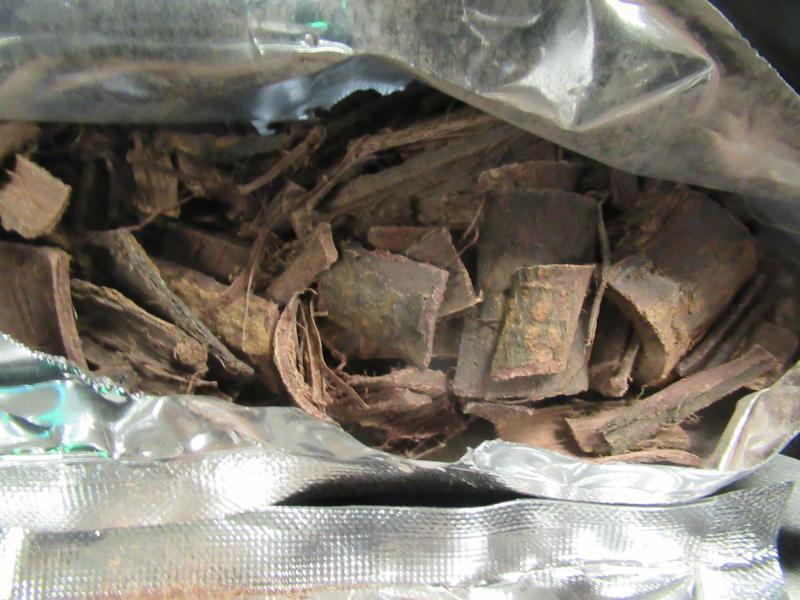
Making DMT the possession and use of DMT are illegal in many countries.
When DMT is extracted from plants, it may also appear in a resinous or sticky form ranging in color from dark brown to reddish-orange. This material is commonly known as “DMT fumarate.”

It cannot be emphasized enough that DMT is a powerful psychoactive substance that carries significant risks, and its use should only be considered under the guidance of a trained healthcare professional.

Get Your Life Back
Find Hope & Recovery. Get Safe Comfortable Detox, Addiction Rehab & Dual Diagnosis High-Quality Care.
Hotline(844) 597-1011What are the Effects of DMT? What are DMT Side Effects?
When taken, DMT can produce a range of effects, including the following:
- Visual Hallucinations: DMT is known for producing incredibly vivid and intense visual hallucinations, often described as “breakthrough” experiences. Users report seeing complex patterns, fractals, vibrant colors, entities encounter, and otherworldly beings. Many DMT art or DMT visuals and DMT drug documentary describe their appearance.
- Intense Emotions: DMT can also produce intense emotional experiences, ranging from euphoria and joy to fear and anxiety. Some users report feeling a sense of awe or reverence for the experience, while others may feel overwhelmed or scared.
- Altered Sense of Time: DMT can also distort one’s perception of time, making minutes feel like hours or hours feel like seconds.
- Changes in Body Sensations: DMT can produce a range of physical sensations, including tingling, numbness, and vibrations. Some users report feeling like they are leaving their bodies or experiencing a sense of unity with the universe.
- Increased Introspection: DMT can also lead to increased self-reflection and introspection, with some users reporting insights into their own lives and consciousness.
DMT in the Brain. What is DMT in the Brain?
DMT drug affects the brain in various ways, primarily by binding to serotonin receptors. Serotonin is a neurotransmitter crucial in regulating mood, appetite, and sleep, among other functions.
When consumed, the DMT effect on the brain quickly crosses the blood-brain barrier and reacts to serotonin receptors, particularly the 5-HT2A receptor. This triggers a cascade of neurochemical events, including the release of norepinephrine and dopamine neurotransmitters and changes in brain activity patterns.
The effects of DMT on the brain can vary widely depending on the dose, route of administration, and individual factors like genetics and mental state. Some of the most common effects of DMT on the brain include the following:
- DMT produces vivid and intense visual and auditory hallucinations, often described as “otherworldly” or “transcendent.”
- Many users report a sense of timelessness or a feeling that time is distorted or slowed down.
- DMT can heighten emotional experiences and lead to profound feelings of joy, awe, or terror.
- Some users report a sense of ego dissolution or a sensation of oneness with the universe.
- DMT is sometimes described as “DMT the Spirit Molecule” because of its capacity to generate deep spiritual experiences or mystical forms of consciousness.
DMT Cart / DMT Vape Pen / DMT Pen
What is DMT cart or vape cart device, or DMT pen? A DMT cart, or vape pen, is used for vaporizing DMT (Dimethyltryptamine), allowing a more convenient and discreet way to consume the substance. DMT carts are essentially cartridges filled with DMT oil or crystal dissolved in a solvent compatible with vape pen batteries. The cartridge is attached to a battery-powered vape pen or mod, and the user inhales the device’s vapor.
Many people prefer using DMT carts over other administration methods, such as smoking or brewing tea, since it can be challenging to determine the appropriate dosage for these methods, and administering them can be cumbersome. DMT pens or carts offer a more precise and controlled way of administering DMT, allowing users to take accurate and measured doses in a controlled manner.
Vaporizing DMT via a vape cart is a potent and intense experience with significant risks and potential side effects. If planning to use a DMT cart, it is vital to ensure the device is safe and reliable and use it only responsibly. Possession of DMT vape pens to smoke the drug is illegal in most countries. The purchase and use of DMT carts may have legal consequences.
What is 5 MeO-DMT?
What is DMT’s variant 5-MeO-DMT (5-methoxy-N, N-dimethyltryptamine) is a powerful psychedelic compound that produces similar effects to DMT but also has some distinct differences. Like DMT, 5-MeO-DMT can induce profound mystical experiences, ego dissolution, and vivid hallucinations.
However, there are some key differences between the two substances. Unlike DMT, 5-MeO-DMT is an endogenous compound naturally produced by some plants and animals, including the Bufo alvarius toad. It is also slightly less well-known and studied than DMT, although research on the compound is increasing.
Another key difference is that 5-MeO-DMT produces a more intense and immediate experience than DMT. The hallucinations induced by 5-MeO-DMT are often described as more abstract and ego-shattering, and the experience can be more physically and emotionally overwhelming.
5-MeO-DMT is a powerful and potentially transformative substance that should be cautiously approached and consumed safely and responsibly. If taking 5 MeO-DMT, confer with a qualified medical professional or a knowledgeable guide and be aware of the legal status of the 5-MeO-DMT drug and the potential risks and side effects.
What is 4-ACO-DMT?
What is DMT variant called 4-AcO-DMT substance has been found to have very similar effects to psilocybin, which is the active component in magic mushrooms. When ingested, it is quickly metabolized and broken down into psilocin, which is responsible for the hallucinogenic effects.
4-AcO-DMT has been used for recreational purposes as well as for scientific research. Studies suggest it may have potential therapeutic applications for depression or anxiety. However, any drug or substance has potential risks and negative effects.
Some users encounter adverse side effects such as paranoia, anxiety, or nausea. The long-term effects of 4-AcO-DMT are not well known due to a lack of research, so it is important to use caution and always follow proper harm-reduction practices when using any substances.
4-AcO-DMT is illegal in many countries, including the United States, Canada, and the United Kingdom. Possession or use of this substance can lead to legal consequences, including charges and fines. Always research the legal status of any substance before considering its use.
What are DMT Visuals Hallucinations?
What is DMT visual? DMT (Dimethyltryptamine) users often report powerful and intense visual hallucinations. These hallucinations range from complex, multicolored geometric shapes and patterns to vivid landscapes and scenes full of futuristic or alien-like entities. DMT-induced visual hallucinations are typically described as otherworldly, transcendent, and beyond the normal human experience.
DMT visuals often involve vivid, intense, and complex visual imagery. DMT visuals are highly individualized and can vary significantly from person to person, but some of the common DMT visuals include:
- Geometric DMT visuals pattern: DMT can cause the perception of abstract geometric patterns that can be simple or intricate. These patterns may appear to be symmetrical, fractal, or kaleidoscopic.
- Eye-like DMT visuals shapes: Some people describe seeing eye-like shapes or entities that may seem conscious, intelligent, or communicate with them.
- Vivid DMT visuals colors: The colors of the DMT visuals tend to be very vibrant and vivid. They may involve a range of colors, including bright neons, pastels, and jewel tones.
- Tunnel DMT visuals visions: Some DMT users may experience a tunnel-like vision where they feel transported to another dimension or world.
- Shapes and objects DMT visuals: DMT can cause individuals to perceive strange objects or shapes such as spheres, pyramids, or cubes.
DMT can cause a range of DMT visuals and other non-visual experiences. Furthermore, the complexity, intensity, and duration of DMT visuals can vary substantially depending on the dose, the setting, and the individual’s previous experience with the drug. Still, DMT visuals include:
- DMT Visual fractals: Complex geometric patterns that appear to morph and shift in color and shape.
- Entity contacts DMT visuals: Many DMT users report encountering and communicating with entities that may appear cartoonish, mechanical, or otherworldly creatures or figures.
- Otherworldly landscapes DMT visuals: Some users describe feeling transported to other dimensions or universes, while others report being immersed in jungle-like environments, cosmic landscapes, or other surreal settings.
DMT visuals are often expressed as intense, vivid, and profound, resulting in many users’ feelings of awe, wonder, and spiritual significance. However, DMT is a powerful psychoactive substance; its use carries potential risks and side effects and should only be consumed safely and responsibly. DMT is illegal the United States and in many other countries.
Get Help. Get Better. Get Your Life Back.
Searching for Accredited Drug and Alcohol Rehab Centers Near You?
Even if you have failed previously and relapsed, or are in the middle of a difficult crisis, we stand ready to support you. Our trusted behavioral health specialists will not give up on you. When you feel ready or just want someone to speak to about therapy alternatives to change your life call us. Even if we cannot assist you, we will lead you to wherever you can get support. There is no obligation. Call our hotline today.
(844) 597-1011What is DMT Art?
DMT art refers to visual art inspired by the psychedelic experiences and visions that users of DMT often report. DMT-induced trance-like states often result in deeply profound and captivating visual hallucinations that have functioned as a basis of inspiration for many artists across the globe. DMT art frequently incorporates bright and vibrant colors, intricate patterns, and otherworldly shapes in a psychedelic style that evokes the intense visual imagery experienced during DMT trips.
DMT art often reflects the spiritual and mystical themes in DMT experiences, including encounters with otherworldly entities, vistas of transcendental landscapes and spaces, or visions of cosmic consciousness. DMT art’s most common motifs include fractal geometry, stylized versions of entities and beings, and kaleidoscopic patterns.
As DMT use has become increasingly popular, many artists globally have started to create DMT-inspired art across various media, including paintings, drawings, digital art, and sculptures. Many DMT enthusiasts consider such art to
What are DMT Elves?
DMT elves, or “machine elves,” are recurring entities many DMT users report encountering during their trips. These creatures are often described as anthropomorphic or insectoid beings, sometimes with shimmering or metallic features, that seem to be living and moving within complex geometric patterns. The name “machine elves” comes from the perception among some users that these beings appear to be operating some sort of mechanical or advanced technology.
DMT elves are often described as brilliant and hyper-dimensional beings with an otherworldly presence that may communicate with users via telepathy or other non-verbal means. Some users report feeling a deep sense of connection, care, and guidance from these entities, while others describe their interactions with DMT elves as intimidating, alienating, or even hostile.
The phenomenon of DMT elves is still unclear. There are various theories about what these entities represent, ranging from projections of the user’s subconscious to genuine communication with beings from other dimensions or universes. Overall, DMT elves remain one of the most fascinating and mysterious aspects of the DMT experience. Their profound impact on users’ spiritual and philosophical outlooks has made them a topic of significant interest among many researchers and enthusiasts.
Where does DMT Come From? What is DMT’s Plant Source?
DMT (Dimethyltryptamine) is a naturally arising psychedelic substance found in several plants and animals and synthesized in a laboratory. DMT is found in what plants? Some DMT plants include the famous Ayahuasca vine in the Amazon rainforest, Psychotria Viridis, Chacruna (Psychotria Alba), Mimosa tenuiflora, Acacia Species, and many others. Many indigenous groups have used the Ayahuasca vine as a key part of traditional medicine and religious ceremonies.
DMT can also be synthesized in a lab. Synthetic DMT is chemically identical to naturally occurring DMT and has the same effects on human consciousness and perception.
DMT is present in small amounts in some mammals, including humans, although it is unclear what role, if any, it plays in the body. Recent research has suggested that it may be critical for regulating brain function and contributing to the brain’s ability to enter meditative and psychedelic states.
Remembering that DMT is a powerful psychoactive substance with significant risks and potential health consequences is vital. DMT use carries legal consequences, and it should only be consumed under the guidance of a qualified healthcare professional or addiction specialist.
What is DMT the Spirit Molecule
DMT is most commonly known for its powerful and profound effects on consciousness, which has led to the nickname “the spirit molecule.”
DMT induces a very intense and short-lived psychedelic experience that can include strong visual and auditory hallucinations, a sense of spiritual awakening, and a feeling of being transported to another realm or dimension. Some users report encountering entities or beings during their experience.
DMT has been used for centuries in shamanic and spiritual contexts, and there is growing interest in its potential therapeutic value for conditions such as depression, anxiety, and addiction. Research on DMT’s effects and potential benefits is still in its early stages, and more studies are needed to understand its mechanisms and potential medical uses better.
Take caution, as the possession and use of DMT and other psychoactive drugs are illegal in many places.
What are DMT Entities?
The concept of “DMT entities” is a frequent topic of discussion in the DMT community, as many users report encountering entities, creatures, or intelligent beings during their DMT experiences. These entities are often described as having a distinct and unique presence or energy and appear highly intelligent and aware of the user’s presence. Some users report undergoing profound or transformative experiences in the presence of these entities, such as feelings of love, understanding, or transcendence.
The existence or nature of these entities is a highly subjective experience that can vary widely from person to person. While some users report highly vivid and realistic encounters, others may not experience any entity or encounter. Approach these experiences with a critical and rational mindset and not to assume that the entities are objectively real or have any extraphysical existence.
While the existence and nature of DMT entities remain a topic of debate and speculation, their presence in DMT experiences has been a source of artistic and creative inspiration for many. Some have even reported encountering DMT entities has profoundly impacted their spiritual beliefs and practices.
Is DMT Addictive?
No scientific evidence suggests that DMT (dimethyltryptamine) is physically addictive. Unlike some other drugs of abuse, such as opioids or stimulants, DMT does not produce physical withdrawal symptoms when use is discontinued. Some studies have suggested that DMT may have the therapeutic potential of DMT treatment for addiction and substance abuse disorders.
However, some individuals may develop a psychological dependency on DMT, mainly if they use it regularly or in large doses. Is DMT addicting? Psychologically, yes. Some users may be drawn to the intense and profound experiences associated with DMT use and may find it challenging to quit the drug once they have begun.
How Long Does DMT Stay in Your System? What is DMT’s Timeline?
Its effects are relatively short, typically lasting between 30 minutes to an hour. Nevertheless, the drug can still be detected in your system for a certain period after ingestion.

How long does DMT stay in system depends on several factors, including the dose, frequency of use, the individual’s metabolism, and the drug test being used. Here are some estimates of how long DMT may stay in different parts of the body:
- Blood: DMT can be detected in the blood for up to 24 hours after ingestion.
- Urine: DMT can be seen in urine for up to 24-72 hours after ingestion, depending on the individual’s metabolism.
- Hair: DMT can be seen in hair follicles for up to 90 days after ingestion.
It’s worth noting that most drug tests do not screen for DMT, as it is not considered a commonly abused substance. However, some specialized drug tests may detect the presence of DMT in your system. If you are concerned about seeing DMT in your system, it’s best to consult with a medical professional or a drug testing expert.
How To Smoke DMT?
Can you smoke DMT? Smoking DMT can produce intense and powerful effects that may be overwhelming or frightening for some individuals. The users reported that utilizing a pipe or a vaporizer is the best way to smoke DMT. Here are the ways to smoke DMT and how much DMT to smoke:
- Load the pipe: Place a small amount of DMT powder onto the mesh screen or bed of herbs (such as mint leaves or parsley) in a glass pipe or bong bowl.
- Heat the pipe: Hold a lighter or torch about an inch below the bowl and slowly heat the DMT until it vaporizes and produces “DMT smoke.” Do not apply the flame directly to the DMT, as it may burn and degrade the substance.
- Inhale the vapor: Once the DMT vaporizes, inhale deeply and hold the smoked DMT in your lungs for several seconds.
Can You Snort DMT?
Snorting DMT (N, N-Dimethyltryptamine) is not a usual method of ingestion and is not recommended as it can cause intense burning and discomfort in the nasal cavity. Moreover, snorting DMT can cause the substance to be absorbed faster into the bloodstream, leading to a more rapid onset of effects that may be overwhelming or unpleasant.
There are some limited exceptions for using legal DMT for research purposes under strict regulatory conditions, but it is not available for medical or therapeutic use outside of clinical trials.
State laws on DMT may vary, and possession or use of DMT may also be illegal under state and federal laws. It is critical to be knowledgeable about your state’s laws and prioritize your safety and well-being when making decisions regarding substance use.
First-class Facilities & Amenities
World-class High-Quality Addiction & Mental Health Rehabilitation Treatment
Rehab Centers TourRenowned Addiction Centers. Serene Private Facilities. Inpatient rehab programs vary.
Addiction Helpline(844) 597-1011Proven recovery success experience, backed by a Team w/ History of:
15+
Years of Unified Experience
100s
5-Star Reviews Across Our Centers
10K
Recovery Success Stories Across Our Network
- Low Patient to Therapist Ratio
- Onsite Medical Detox Center
- Comprehensive Dual-Diagnosis Treatment
- Complimentary Family & Alumni Programs
- Coaching, Recovery & Personal Development Events
N,N-Dimethyltryptamine / DMT Drug Facts
What is DMT? DMT Drug Facts Chart.
| What is DMT? | DMT Meaning |
|---|---|
| DMT Trip experience | Tripping on DMT feels quiet, spiritual, freighting, and confusing. During DMT tripping, users hallucinate or see things that aren’t there. Reading below for more on DMT tripping. |
| DMT’s Effects | The primary effects of the DMT drug include increased blood pressure, heart rate & feeling sick. Continue reading below for complete DMT side effects. |
| How Long Does DMT Last? | While DMT trips can be powerful, they typically do not last long. Continue reading for more in-depth details. |
| Drugs with DMT | Drugs with DMT include Ayahuasca, Changa, Bufotenin & 5-MeO-DMT. Continue reading below for more in-depth details. |
| Dangers of DMT | Is DMT dangerous? Yes, the dangers of the DMT drug include increased heart rate, blood pressure, and nausea/vomiting. DMT trips can lead to flashbacks and mental health problems. Continue reading below for more in-depth details. |
What is the Drug DMT?
What is DMT drug? DMT is a potent hallucinogenic found in plants. DMT drugs are smoked, snorted, and mixed with Ayahuasca. “DMT the spirit molecule”, also called Ayahuasca and Dimitri is used to get high. Continue reading more about what a DMT cart or a DMT trip is like and uncover DMT use side effects & dangers.
What is DMT? N, N-Dimethyltryptamine (DMT) is an indole alkaloid discovered in plants and animals. It is known for creating brief and intense psychedelic results when consumed. Increasing evidence indicates endogenous DMT plays essential roles in several peripheries and central nervous system processes and may act as neurotransmitters. However, DMT treatment is illegal in the US and is only examined and researched in underground clinics.
Where Does DMT Come From?
DMT (N, N-Dimethyltryptamine) is a naturally occurring psychedelic substance in various plants and animals, including certain ayahuasca vines, acacia trees, and toads. DMT is a part of traditional shamanic practices in South America, where it is consumed as part of an ayahuasca ceremony. Other DMT after extractions also contains other plant ingredients that enhance the effects of DMT.
DMT may be made in a laboratory, typically produced from tryptamine, an amino acid found in many living organisms, through a chemical process called methylation. Synthetic DMT can be found in a crystalline form and is commonly smoked or vaporized for its psychoactive effects.
DMT Extraction
Extracting DMT can be complex and potentially hazardous, requiring specialized knowledge and equipment. To extract DMT, methods may also vary depending on the source of DMT, as the substance can be obtained from various plants and animals, each with unique extraction methods.
The research on DMT is ongoing, and new studies are being conducted to understand its effects and potential therapeutic applications. It is essential to approach the subject of DMT with caution and to prioritize safety and well-being when making decisions regarding substance use.
What is 4-ACO-DMT?
4-AcO-DMT, also known as psilacetin, is a synthetic psychedelic substance prodrug of psilocin. It is often referred to as a research chemical because it has not been extensively studied or approved for human consumption in most countries. Users commonly report a euphoric and hallucinogenic experience, with effects similar to psilocybin mushrooms or LSD. It is worth noting that it is important to exercise caution and avoid using psychoactive substances without proper medical guidance and supervision due to the lack of regulation and quality control.
How is DMT Made?
Making DMT (Dimethyltryptamine) involves extracting the compound from plants, most commonly Phalaris arundinacea or Mimosa hostilis. Yet, making DMT is complex, requires specialized knowledge and equipment, and can be dangerous. Thus, attempting to make DMT without proper guidance and expertise is not recommended.
However, the basic steps involved in DMT extraction from plants are as follows:
- Obtain plant material that contains DMT, such as Phalaris arundinacea or Mimosa hostilis.
- Crush the plant material and soak it in a suitable solvent, typically a mix of water and a pH-balanced solution.
- Use a base, such as sodium hydroxide, to adjust the pH of the solution, making the DMT more soluble.
- Add a non-polar solvent such as naphtha or petroleum ether, which causes the DMT to dissolve.
- Separate the solvent using a separatory funnel, and allow it to evaporate, resulting in the DMT in its freebase form.
- The freebase can then be converted to DMT fumarate, a more stable and water-soluble salt, by adding fumaric acid.
Making DMT is highly technical and requires specialized knowledge and equipment to ensure the extraction is safe and high-quality. Therefore, before attempting to make DMT, consulting with a qualified healthcare professional or an experienced and knowledgeable guide is recommended. Additionally, it is critical to remember that DMT is illegal in most countries and its abuse has serious health and legal consequences.
DMT Legality
DMT is a Schedule 1 controlled drug in the US. This means it is prohibited to manufacture, buy, possess, or distribute the drug. The substance has a high potential for misuse, no government-recognized medical use, and no accepted drug-use safety parameters.
Researchers can examine or use DMT under a Schedule I research registration requiring approval from the DEA (Drug Enforcement Administration) and the FDA (Food and Drug Administration). Despite its illicit status, some groups of individuals occasionally use DMT in religious ceremonies and diverse settings for an “awakening” or to obtain “deep spiritual insight.”
DMT Molecular Structure
![DMT Drug DMT molecule structure. In the history of DMT drug-containing “remedies,” ayahuasca has perhaps the longest record. [1]](https://welevelup.com/wp-content/uploads/2023/04/DMT-Drug-1.jpg)
Does DMT Show Up in a Drug Test?
Yes, DMT (N, N-Dimethyltryptamine) can appear on a drug test. However, it is not typically included in standard drug screening tests, as it is not a commonly abused substance.
It is not typically included in standard workplace drug tests that screen for THC, cocaine, opioids, and amphetamines. If you have concerns about a drug test for DMT or the effects of DMT use, it’s crucial to consult with an accredited and qualified healthcare professional.
DMT Vape Pen. DMT Pens.
DMT pens, also known as DMT vape pens or cartridges, are a newer and increasingly popular way of consuming DMT conveniently and discreetly. These devices are essentially pre-filled cartridges containing DMT oil or dissolved DMT crystals in a solvent compatible with vape pen batteries.
A DMT vape pen vaporizes Dimethyltryptamine, allowing a more convenient and discreet way of consuming the substance. DMT vape pens or vape cartridges make it more manageable for users to calculate doses of the substance accurately.
To use a DMT vape pen, the cartridge is attached to the battery-powered device and heated, producing a vapor that can be inhaled. Vaping DMT offers a more precise and controlled way of administering the substance, providing an accurate and measured dose.
Vaporizing DMT via a vape pen is still a potent and intense experience with significant risks and potential side effects. The use of DMT in any form should be approached with caution and only consumed safely and responsibly, preferably under the guidance of a qualified healthcare professional or addiction specialist.
Smoking via DMT vape pens is illegal in most countries, including the United States. Buying or selling DMT vape pen may result in legal consequences.
Drugs with DMT
DMT is a psychedelic drug that produces intense spiritual and mystical experiences in users.
Here are some other drugs that contain DMT or are similar in chemical structure:
- Ayahuasca: This South American psychedelic brew is made from the ayahuasca vine and other plant materials. Ayahuasca contains DMT and other psychoactive compounds, and it has been used for centuries in traditional healing ceremonies.
- 5-MeO-DMT: This is a related psychedelic compound found in some plants and used in traditional healing practices. 5-MeO-DMT produces intense, short-lived effects that can be either euphoric or deeply unsettling.
- Bufotenin, also known as 5-HO-DMT, is another psychedelic compound in certain plant and animal species. Bufotenin produces psychedelic effects similar to DMT, but the experience can be more intense and longer-lasting.
- Psilocybin is the main psychoactive compound in “magic mushrooms,” another psychedelic drug type. Psilocybin produces similar effects to DMT, including altered perceptions and profound spiritual experiences.
It’s worth noting that DMT and other psychedelic drugs can be illegal in many countries, and their use carries certain risks, including psychological distress, panic reactions, and flashbacks. It’s important to approach the use of these substances with caution and to seek professional guidance and support if you plan to use them for any reason.
DMT Drug Factsheet
Download the below PDF for what is a DMT drug. N,N-DIMETHYLTRYPTAMINE (DMT) facts sheet was publicly available and provided by the DEA (Drug Enforcement Administration) for drug abuse awareness.

Get Your Life Back
Find Hope & Recovery. Get Safe Comfortable Detox, Addiction Rehab & Dual Diagnosis High-Quality Care.
Hotline(844) 597-1011DMT Addiction Statistics
Lifetime hallucinogen use in the United States is prevailing and highly comorbid with other drug use and psychiatric illnesses. Hallucinogen addiction is relatively uncommon, with a low risk of development following hallucinogen exposure. However, significant connections exist between hallucinogen use and substance use disorders, personality disorders, PTSD, and past suicide attempts. [2]
38%
In 2017, about 38 percent of adults in the US battled an illicit substance use disorder.
Source: NSDUH
60%
Sixty percent of the public knows somebody who has struggled with drug addiction, and 62 percent consider the problem widespread.
Source: CDC
9.32%
Prevalence of twelve-month and lifetime hallucinogen use was 0.62 percent and 9.32 percent, respectively.
Source: NCBI
Get Help. Get Better. Get Your Life Back.
Searching for Accredited Drug and Alcohol Rehab Centers Near You?
Even if you have failed previously and relapsed, or are in the middle of a difficult crisis, we stand ready to support you. Our trusted behavioral health specialists will not give up on you. When you feel ready or just want someone to speak to about therapy alternatives to change your life call us. Even if we cannot assist you, we will lead you to wherever you can get support. There is no obligation. Call our hotline today.
(844) 597-1011Top 10 What drug is DMT? FAQs
-
What does DMT smell like? What is DMT’s odor like?
DMT (Dimethyltryptamine) is a white crystalline powder that is typically odorless. But it may have a slight chemical smell or odor when heated or vaporized. When DMT is vaporized or smoked, it can produce a distinctive smell described as plastic-like, burnt, or similar to burning electrical insulation or mothballs. This odor can be strong and noticeable, especially in confined spaces.
-
What does DMT taste like? What is DMT’s taste like?
DMT drug has a bitter, chemical taste. It is often described as similar to burnt plastic or rubber taste. The flavor can be intense and unpleasant; some may experience nausea or vomiting after ingesting DMT due to its bitter taste. When used in a vaporized form, the DMT drug can have a more intense and immediate effect than when ingested orally. Some users report that vaporized DMT tastes milder than when ingested orally, but it can still be unpleasant.
-
What type of drug is DMT?
What is DMT drugs? DMT (Dimethyltryptamine) is a potent psychedelic substance that belongs to the tryptamine family of compounds. It occurs naturally in various plant species and is produced synthetically as a recreational drug or a psychedelic therapy tool. The DMT drug is classified as a Schedule 1 controlled drug in many countries, including the United States, meaning it is considered to have a high potential for drug misuse and no recognized medical use. In the United States, DMT is classified as a Schedule 1 illicit drug under the Controlled Substances Act, along with other drugs such as heroin, LSD, and marijuana.
-
How long is DMT in your system? What is DMT’s timeline?
The duration of the DMT drug (Dimethyltryptamine) in your system can depend on various factors, including the method of administration, frequency of use, and individual metabolism. DMT is rapidly metabolized and eliminated from the body, with a half-life of about 15 minutes. This means that after 15 minutes, the concentration of DMT in the body is reduced by half. However, the metabolites of DMT can be found in urine for 24 hours after use. Hair tests can detect DMT drug use for longer, as traces of the drug can remain in the hair for up to ninety (90) days after use. However, hair testing is not typically used to screen for DMT drug use.
-
How long does DMT last?
The duration of the effects of DMT (Dimethyltryptamine) may differ based on the form of administration, the dose, and individual factors such as metabolism and tolerance.
-
Is DMT illegal?
Does DMT show up on drug tests? Yes. In the United States, DMT possession, sale, and use are illegal under federal law, and penalties can include fines and imprisonment. The use of DMT may also have serious risks, including psychological distress, panic reactions, and potential long-term effects on mental health.
-
What does DMT stand for?
Whats DMT drug? DMT stands for “Dimethyltryptamine.” The common street names for DMT are Dimitri, The Spirit Molecule, and The Rogan. Dimethyltryptamine is a powerful psychedelic drug. However, DMT drugs can be associated with severe risks, including psychological distress, panic reactions, and potential long-term effects on mental health.
-
What does a DMT trip look like?
DMT trips can be intense and overwhelming, and users may experience various emotional and psychological effects. Some users report euphoria, spiritual awakening, or connectedness to a larger universe. Others may experience anxiety, fear, or paranoia. A DMT trip can be a very intense and profound experience, with effects that vary from person to person. The results of a DMT trip can depend on the method of administration, the dose, and individual factors such as metabolism and tolerance.
-
Can you get addicted to DMT?
The DMT drug is not generally considered an addictive substance in the traditional sense, as it does not produce physical dependency or withdrawal symptoms. However, some users may develop a psychological dependence on the drug, mainly if they use it frequently or in large doses. DMT can produce intense and powerful hallucinations, and some users may be drawn to the experience and seek it out repeatedly. This can be a sign of psychological dependence, in which the user feels a need to use the drug to cope with stress or other issues in their life.
-
Where to get DMT?
In the United States, possession, sale, and use of DMT drugs are illegal under federal law, and penalties can include fines and imprisonment. The use of DMT may also have serious risks, including psychological distress, panic reactions, and potential long-term effects on mental health.
-
What is DMT?
DMT, short for N, N-Dimethyltryptamine, is a powerful and fast-acting psychedelic substance found in some plants and animals, including humans. It can be ingested, injected, or inhaled to achieve its psychoactive effects. DMT is classified as a Schedule I controlled substance in the United States and illegal in many countries.
DMT is known for its profound and intense mental and consciousness effects. It has been described as inducing a rapid and intense trip or spiritual experience lasting anywhere from a few minutes to an hour. DMT is believed to work by binding to serotonin receptors in the brain, which can lead to profound changes in mood, perception, and thought.
First-class Facilities & Amenities
World-class High-Quality Addiction & Mental Health Rehabilitation Treatment
Rehab Centers TourRenowned Addiction Centers. Serene Private Facilities. Inpatient rehab programs vary.
Addiction Helpline(844) 597-1011Proven recovery success experience, backed by a Team w/ History of:
15+
Years of Unified Experience
100s
5-Star Reviews Across Our Centers
10K
Recovery Success Stories Across Our Network
- Low Patient to Therapist Ratio
- Onsite Medical Detox Center
- Comprehensive Dual-Diagnosis Treatment
- Complimentary Family & Alumni Programs
- Coaching, Recovery & Personal Development Events
The DMT Experience & DMT Function
The hallucinations induced by DMT can be intense and vivid and vary from person to person. Commonly reported visual effects are seeing geometric patterns, fractals, and brighter and more intense colors than usual. Some users also report seeing complex, three-dimensional objects or landscapes that seem alive and in motion.
DMT How long does it last? The DMT experience typically lasts 10 to 20 minutes, although some users may experience a longer or shorter trip. During this time, the user may experience a range of emotional and psychological states, from euphoria and awe to terror and paranoia. In addition to visual effects, DMT can induce auditory hallucinations, including sounds that seem to come from other dimensions or sources, as well as a heightened awareness of one’s body and surroundings.
Another common experience reported by DMT users is encountering entities or beings with a profound and intelligent presence. These entities may take on various forms, from alien-like creatures to spiritual figures from multiple cultures or mythologies. Some users even report communicating with these entities or receiving messages from them. While the experiences induced by DMT can be profound and transformative, they are also highly subjective and vary from person to person, and the same goes for how long does DMT last for anyone.

Other Negative Effects of DMT
While DMT can have profound and positive effects on some users, it can also negatively affect others. Some potential adverse effects of “spiritual” DMT therapy and use include the following:
- Psychological Distress: Some users may experience intense fear, anxiety, or paranoia during their DMT trip. This can be particularly distressing if they lose control or feel trapped in a negative or frightening hallucination.
- Physical Effects: DMT can cause physical side effects such as nausea, vomiting, elevated heart rate, and blood pressure. In infrequent cases, it can also provoke seizures or respiratory distress.
- Flashbacks: Some users may experience flashbacks or persistent changes in perception or mood long after the effects of the drug have worn off.
- Legal Consequences: DMT is illegal in many countries and can carry severe legal consequences for possession, use, or distribution.
- Risk of Accidents: DMT can impair judgment and reaction time, increasing the risk of accidents or injury.
- Risk of Addiction: While DMT is not considered physically addictive, some users may develop a psychological dependence on the drug, leading to compulsive use and other negative consequences.
How Long Does A DMT Trip Last?
The duration of a DMT trip can vary based on the manner of consumption and the individual’s physical and mental state. Generally, a DMT trip will last 10-20 minutes when smoked or vaporized and up to 45 minutes when taken orally with an MAOI (a type of inhibitor).
During the peak of a DMT trip, users may experience intense and profound hallucinations, a sense of timelessness, and a feeling of detachment from their physical body. The effects can be highly subjective, and some users may report feeling as if they have been transported to another dimension or alternate reality, encountering entities or beings that they believe to be aware and intelligent.
After the peak of the trip, the effects of DMT will gradually wear off, and users may experience residual effects, such as changes in mood or perception, for several hours afterward.
DMT Long-Term Effects
There needs to be more study and research on the long-term effects of DMT, as it is a reasonably new field of study, and the use of DMT is illegal in many countries. However, some potential long-term effects of DMT use may include the following:
- Persistent Changes in Perception or Mood: Some users may report constant changes in their perception or mood long after the effects of the drug have worn off, which may include altered visual perception, emotional sensitivity, or changes in personality or worldview.
- Flashbacks: Some users may experience flashbacks or recurring experiences similar to those during their DMT trip, even months or years after the drug was last used.
- Psychological Distress: In rare cases, DMT use may trigger or exacerbate underlying mental health conditions such as anxiety, depression, or psychosis.
- Addiction or Compulsive Use: While DMT is not considered physically addictive, some users may develop a psychological dependence on the drug, leading to compulsive use and other negative consequences.
DMT and Anxiety
Like other psychedelics, DMT drugs can produce emotional and psychological effects, including anxiety. While some users may experience euphoria and spiritual connection, others may experience intense anxiety, paranoia, or panic.
DMT drugs can also trigger or exacerbate underlying mental health conditions such as psychosis, depression, or anxiety disorders.
In some cases, DMT drugs may have potential therapeutic effects for anxiety and other mental health conditions. There is ongoing research on DMT effects on depression and other psychedelics in treating anxiety and post-traumatic stress disorder (PTSD). However, using DMT for therapeutic research should only be done under the guidance of an experienced and qualified healthcare professional in a controlled and regulated setting. Some other groups, such as DMT Nexus, conduct comprehensive research for DMT.
If you are undergoing anxiety or additional mental health concerns, seeking support from a healthcare professional or a mental health treatment program may be helpful. Many resources are available for those seeking help with anxiety or other mental health issues.
Extraction of DMT
How to make DMT? DMT can be extracted from certain plants using several different extraction methods.
One of the most common methods involves using a nonpolar solvent such as naphtha or heptane to dissolve the DMT from the plant material. The solvent evaporates, leaving behind a sticky brown resin containing the DMT.
Short-Term Effects of DMT
Looking for DMT meaning? It means “dimethyltryptamine.” It is a powerful psychedelic substance that can produce various side effects of DMT. These can include the following short-term effects:
- Intense Visual and Auditory Hallucinations: DMT can produce vivid, complex, and highly realistic hallucinations, including geometric patterns, bright colors, and images of entities or otherworldly beings.
- Alterations in Perception of Time and Space: Users may experience a sense of timelessness or detachment from their physical body and altered perceptions of space and distance.
- Changes in Mood and Emotion: DMT can produce a range of emotional states, including euphoria, anxiety, and intense introspection.
- Physiological Effects: DMT can also cause changes in heart rate, body temperature, and blood pressure, as well as nausea, dizziness, and tremors.
- Spiritual or Mystical Experiences: Some users may feel a profound connection to the universe, a higher power, and a deep sense of meaning and purpose.

DMT Drug Test
Are you wondering, “Does DMT show up on a drug test?” Yes. If you are being tested for DMT, you are likely undergoing a drug test for a specific reason, such as employment, probation, or medical reasons. DMT can be detected in various drug tests, including urine, blood, saliva, and hair tests.
The time that DMT can be caught in the body relies on several factors, including the dose, frequency of use, and the individual’s metabolism. In general, DMT is rapidly metabolized and eliminated from the body, and it is typically detectable in urine for up to 24-72 hours after use.
Can You Overdose on DMT Drugs?
While having an adverse reaction or experiencing a “bad trip” from using a DMT drug is possible, it is generally not considered toxic. It is unlikely to cause overdose DMT acute symptoms in the traditional sense. Unlike other medications such as opioids or stimulants, DMT does not appear to directly affect vital bodily functions such as heart rate or breathing. However, as with any powerful psychoactive substance, there are risks associated with its use, including psychological distress, disorientation, and even injury due to impaired judgment or coordination.
However, once combined with other drugs, the inconsistency in dosing could lead to a DMT overdose with the amplified effects of other substances, where the person takes too much, and it has detrimental health effects. Suppose you are considering using DMT drugs or any other psychoactive substance. In that case, it is crucial to educate yourself on the risks and potential consequences and to seek professional guidance and support if needed.
DMT Addiction Treatment
There is currently no recognized pharmacological treatment for DMT addiction. However, addiction treatment programs can help individuals overcome problematic DMT use and address any underlying mental health issues contributing to their drug use.
Treatment for DMT addiction may include behavioral therapies such as cognitive-behavioral therapy (CBT) or contingency management, which can help individuals learn coping skills and identify triggers for drug use. Also, support groups such as Narcotics Anonymous or SMART Recovery can provide ongoing support and encouragement for individuals in recovery. Completing the Narcotics Anonymous steps won’t miraculously end your desire to use drugs. Many successful recovered addicts still find themselves with cravings even decades later. But 12 Steps fellows are urged to replicate this process as often as required for long-term recovery.
Substance abuse treatment is not a one-size-fits-all process. Individuals may require different types or levels of care. A professional assessment and individualized treatment plan can help ensure that individuals receive the appropriate care and support for their unique needs. If you or someone you’re concerned with is struggling with DMT addiction, seeking professional help and support is necessary as soon as possible. Contacting a licensed addiction treatment provider or your doctor can be an ideal first step toward getting the help needed to overcome addiction.

DMT drug is not known to cause physical dependence or withdrawal symptoms, so a traditional detox process is not typically necessary. However, individuals who have used DMT may experience psychological effects such as mood swings, anxiety, or depression after stopping use. Sometimes, these symptoms can be severe enough to warrant professional treatment or support.
If you are experiencing distressing psychological symptoms after stopping DMT use, it is crucial to seek professional help. A mental health professional can provide counseling, therapy, or other interventions to help manage symptoms and support recovery.
Addressing any underlying mental health struggles that may have contributed to DMT use is also essential. Dual diagnosis treatment, which addresses substance use disorders and co-occurring mental health disorders, may benefit individuals with complex or severe mental health needs.
While a traditional detox process may not be necessary for DMT use, seeking professional help and support is critical if you struggle with psychological symptoms after stopping use. Contact We Level Up now for treatment resources and options. Each call is private and confidential.
Dual Diagnosis Treatment at We Level Up Treatment Center
Dual diagnosis treatment at the We Level Up treatment centers is an integrated treatment that addresses both drug use and co-occurring mental health disorders. It recognizes that addiction and mental health are often intertwined and must be treated simultaneously for the individual to achieve long-term recovery.
Traditional addiction treatment alone may not be sufficient for individuals with a dual diagnosis, as underlying psychiatric disorders may continue to contribute to drug use or impede recovery. Dual-diagnosis treatment addresses the addiction and the underlying mental health disorder through various interventions, including medication-assisted treatment, therapy, counseling, and support groups.
Some common mental health disorders that may co-occur with addiction include depression, anxiety, post-traumatic stress disorder (PTSD), bipolar disorder, and schizophrenia. Dual-diagnosis treatment may involve specialized care or additional support to address these conditions alongside addiction. Dual-diagnosis treatment can be provided in various settings, including inpatient drug rehab or residential rehab programs. It may involve a team of healthcare professionals such as psychiatrists, psychologists, social workers, and addiction counselors.
Overall, dual diagnosis treatment is an essential approach to treating addiction and mental health issues and can help individuals achieve long-term recovery and improved quality of life. If you or someone you’re concerned with is toiling with addiction, and a co-occurring mental health conditions, seeking professional help and support is an essential first step toward recovery.
World-class, Accredited, 5-Star Reviewed, Effective Addiction & Mental Health Programs. Complete Behavioral Health Inpatient Rehab, Detox plus Co-occuring Disorders Therapy.
CALL(844) 597-1011End the Addiction Pain. End the Emotional Rollercoaster. Get Your Life Back. Start Drug, Alcohol & Dual Diagnosis Mental Health Treatment Now. Get Free No-obligation Guidance by Substance Abuse Specialists Who Understand Addiction & Mental Health Recovery & Know How to Help.
Top 10 What Kind of Drug is DMT? FAQs
-
What is DMT the drug?
DMT, what is it? N, N-Dimethyltryptamine (DMT) is an indole alkaloid widely found in animals and plants. It is best known for creating brief and intense psychedelic effects when consumed.
-
How do you smoke DMT? What is DMT snorting?
After being extracted, people can take DMT by smoking. The most typical way to take DMT is to smoke it. However, it can also be vaporized, snorted, or injected.
-
How to get DMT?
DMT can be produced synthetically. However, DMT has no approved medical use in the US, and it is illegal to distribute or possess drugs with DMT and N N DMT itself.
-
Does DMT show on a drug test? What is DMT’s drug test duration?
Does DMT show up in drug tests? Many drug testing centers utilize a 5-panel, 10-panel, or 12-panel drug test for general drug addiction. This screening typically detects some combination of amphetamines, benzodiazepines, cannabis, cocaine, ecstasy, opioids, and PCP (Phencyclidine). These tests generally do not test for DMT or other psychedelic drugs. However, it’s likely for a drug test to check, particularly for DMT, if there’s a reason to suspect the drug addiction.
-
What are the long-term effects of DMT? What is DMT’s long-term dangers?
Like many psychedelic substances, the evidence suggests that DMT does not cause physical dependency. Nevertheless, you can still become psychologically dependent on the effects of DMT on the brain.
Some individuals who use DMT may experience intense and vivid flashbacks or “acid flashbacks” long after using the drug. These flashbacks can manifest as sensory disturbances, visual disturbances, or psychological effects.
-
What is a DMT frog (What is DMT frog)?
A type of frog known as the “DMT toad” exudes toxins from glands within its skin and releases psychoactive properties. Some suspect it is the Sonoran Desert toad.
-
What are DMT carts? What is DMT Cart Vs. Vape pen or Vaporizer?
DMT cartridges are designed to be used with a compatible DMT vape pen or vaporizer battery and are typically sold by underground or online markets.
A DMT cart or cartridge is a container that holds a concentrated form of DMT oil or liquid. This oil is derived from DMT-containing plants and is often extracted using specialized equipment and solvents. A DMT cart is designed to be used with a specific type of vaporizer known as a “vape pen” or a vaporizer battery with a 510-thread connection. The vape pen or vaporizer battery heats the DMT oil and turns it into a vapor that can be inhaled.
A vape pen or vaporizer is a device used to vaporize substances for inhalation. It comprises a rechargeable battery, a heating element or coil, and a cartridge or tank that vaporizes the substance. When activated, the heating element rapidly heats the substance, transforming it into a vapor that can be inhaled. A vaporizer is often considered a safer and more discreet alternative to smoking or other inhalation forms.
-
What are DMT entities? What is DMT entity?
The DMT in brain phenomenon of seeing entities from the effects of DMT in the brain is not well understood, and there is no scientific evidence to support the existence of these entities outside of subjective reports from users. Some users also reported seeing “elves DMT” hallucinations. While encounters with DMT brain entities can be a profound and transformative experience for some users, they can also be overwhelming or frightening for others.
-
What is 5 MEO DMT? What is DMT Vs. 5 MEO DMT?
5-MEO-DMT, or 5-methoxy-N, N-dimethyltryptamine, is a strong and fast-acting psychedelic substance structurally similar to N, N-dimethyltryptamine. 5MEO DMT is found in specific plant species and the Sonoran Desert toad (Bufo alvarius) venom and is known for creating intense and transformative psychedelic experiences.
DMT (Dimethyltryptamine) and 5-MeO-DMT (5-methoxy-N, N-dimethyltryptamine) are two different psychedelic substances that produce distinct effects on the body and mind.
What is DMT: DMT is a naturally occurring substance found in certain plants, seeds, and animals, including the Amazonian brew ayahuasca. DMT is known for producing intense and vivid hallucinations, changes in perception and time distortion, and profound experiences of spiritual or mystical significance. The effects of DMT use typically last between 30 and 60 minutes, although some individuals may experience residual effects that last for several hours or days.
What is 5-MeO-DMT: 5-MeO-DMT is a synthetic substance chemically similar to DMT found in several plant and animal species. 5-MeO-DMT is known for producing a more extreme and overwhelming experience than DMT. It can produce intense and rapid changes in perception, profound experiences of ego dissolution, and spiritual or mystical experiences.
The effects of 5-MeO-DMT use typically last between 20 and 90 minutes, although they can vary depending on the dosage, mode of administration, and individual factors.
DMT and 5-MeO-DMT are classified as Schedule I controlled substances in the United States, meaning they have a high prospect for misuse and no presently acknowledged medical use.The use of DMT or 5-MeO-DMT should not be taken lightly and should only be done under the guidance of a trained and licensed healthcare professional.
-
What is 4 ACO DMT? What is DMT Vs. 4 ACO DMT?
4-ACO-DMT, or 4-Acetoxy-N, N-dimethyltryptamine, is a synthetic psychedelic substance chemically identical to psilocybin. Psilocybin is a hallucinogenic chemical discovered in “magic mushrooms” and is consumed for its hallucinogenic effects.
DMT (Dimethyltryptamine) and 4-AcO-DMT (4-Acetoxy-N, N-dimethyltryptamine) are related tryptamine compounds with similar psychoactive effects on the human body and nervous system, but they differ in their composition and pharmacological properties.
What is DMT: DMT is a natural substance found in plants, seeds, and animals, including the Amazonian elixir ayahuasca. DMT is known for producing intense and dazzling hallucinations, changes in perception and time misshaping, and deep experiences of spiritual or mystical significance.
The effects of DMT use normally last between 30 and 60 minutes, although some people may feel residual effects that last for several hours or days.
What is 4-AcO-DMT: 4-AcO-DMT is a semi-synthetic compound emanating from psilocin, the active hallucinogenic ingredient found in “magic mushrooms.” 4-AcO-DMT is known for producing similar effects to those of DMT, including intense and striking hallucinations, shifts in perception and time warping, and profound experiences of a spiritual or mystical nature.
The effects of 4-AcO-DMT use normally last between four to six hours, relying on the dosage, method of administration, and individual factors.
These substances can have risks and adverse effects, including psychological distress, paranoia, anxiety, and other health complications, especially outside a controlled and medically supervised setting.
-
What is DMT?
DMT, known as N, N-Dimethyltryptamine, is a powerful and speedy psychedelic drug. It’s classified as a Schedule I drug in the United States, meaning it can’t be used for medical purposes. It carries an elevated risk of abuse with no accepted medical use. Due to its illegal status, DMT has been given many street names, including Dimitri, Businessman’s Trip, Fantasia, and The Spirit Molecule.
What is DMT Drug? Video.
What is DMT? How long is a DMT high? The peak of the effects DMT experience, known as “DMT tripping,” may only last a few minutes. However, it’s worth noting that DMT can distort the subjective experience of time, so users may perceive the duration of the experience differently than it is. Furthermore, the DMT after-effects can vary depending on the method of administration and the individual user’s tolerance and sensitivity to drugs like DMT.
Experience Transformative Recovery at We Level Up Treatment Centers.
See our authentic success stories. Get inspired. Get the help you deserve.
Start a New Life
Begin with a free call to an addiction & behavioral health treatment advisor. Learn more about our dual-diagnosis programs. The We Level Up Treatment Center Network delivers recovery programs that vary by each treatment facility. Call to learn more.
- Personalized Care
- Caring Accountable Staff
- World-class Amenities
- Licensed & Accredited
- Renowned w/ 100s 5-Star Reviews
We’ll Call You
Search We Level Up DMT Drug Detox, Mental Health Topics & Resources
Sources
[1] Barker SA. N, N-Dimethyltryptamine (DMT), an Endogenous Hallucinogen: Past, Present, and Future Research to Determine Its Role and Function. Front Neurosci. 2018 Aug 6;12:536. DOI: 10.3389/fnins.2018.00536. PMID: 30127713; PMCID: PMC6088236. What is DMT?
[2] Shalit N, Rehm J, Lev-Ran S. Epidemiology of hallucinogen use in the U.S. results from the National epidemiologic survey on alcohol and related conditions III. Addict Behav. 2019 Feb;89:35-43. DOI: 10.1016/j.addbeh.2018.09.020. Epub 2018 Sep 16. PMID: 30245407. What is DMT?
[3] Dos Santos RG, Bouso JC, Rocha JM, Rossi GN, Hallak JE. The Use of Classic Hallucinogens/Psychedelics in a Therapeutic Context: Healthcare Policy Opportunities and Challenges. Risk Manag Health Policy. 2021 Mar 5;14:901-910. DOI: 10.2147/RMHP.S300656. PMID: 33707976; PMCID: PMC7943545. What is DMT?
[4] Schlag AK, Aday J, Salam I, Neill JC, Nutt DJ. Adverse effects of psychedelics: From anecdotes and misinformation to systematic science. J Psychopharmacol. 2022 Mar;36(3):258-272. DOI: 10.1177/02698811211069100. Epub 2022 Feb 2. PMID: 35107059; PMCID: PMC8905125. What is DMT?
[5] National Research Council (US) Committee on Substance Abuse Prevention Research; Gerstein DR, Green LW, editors. Preventing Drug Abuse: What do we know? Washington (DC): National Academies Press (US); 1993. 1, Illicit Drug Use in the United States. Available from: https://www.ncbi.nlm.nih.gov/books/NBK234579/ What is DMT?
[6] Matzopoulos R, Morlock R, Morlock A, Lerer B, Lerer L. Psychedelic Mushrooms in the USA: Knowledge, Patterns of Use, and Association With Health Outcomes. Front Psychiatry. 2022 Jan 3;12:780696. DOI: 10.3389/fpsyt.2021.780696. Erratum in: Front Psychiatry. 2022 Mar 23;13:877390. PMID: 35046855; PMCID: PMC8761614. What is DMT?
[7] Drug Enforcement Administration (DEA). (January 2013). N, N-DIMETHYLTRYPTAMINE (DMT) What is DMT?
[8] National Institute on Drug Abuse (NIDA). (February 2015). How Do Hallucinogens (LSD, Psilocybin, Peyote, DMT, and Ayahuasca) Affect the Brain and Body? What is DMT?
[9] Tupper KW, Wood E, Yensen R, Johnson MW. Psychedelic medicine: a re-emerging therapeutic paradigm. CMAJ. 2015 Oct 6;187(14):1054-1059. DOI: 10.1503/cmaj.141124. Epub 2015 Sep 8. PMID: 26350908; PMCID: PMC4592297. What is DMT?
[10] Winstock, A., Kaar, S., & Borschmann, R. (January 2014). Journal of Psychopharmacology. Dimethyltryptamine (DMT): prevalence, user characteristics, and abuse liability in a large global sample. What is DMT?
